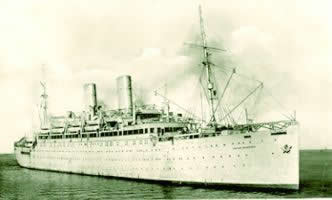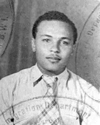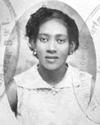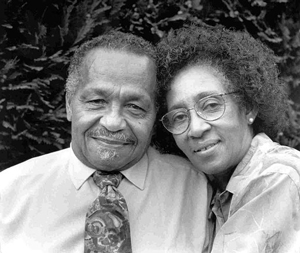
The Empire Windrush
Black History Month 2007

The Empire Windrush's voyage from the Caribbean to Tilbury took place in 1948. Believe it or not, very few of the migrants intended to stay in Britain for more than a few years.
If it hadn't been for the Second World War, the Windrush and her passengers might not have made the voyage at all. During the war, thousands of Caribbean men and women had been recruited to serve in the armed forces.
When the Windrush stopped in Jamaica to pick up servicemen who were on leave from their units, many of their former comrades decided to make the trip in order to rejoin the RAF. More adventurous spirits, mostly young men, who had heard about the voyage and simply fancied coming to see England, 'the mother country', doubled their numbers.
June 22nd 1948, the day that the Windrush discharged its passengers at Tilbury, has become an important landmark in the history of modern Britain; and the image of the Caribbeans filing off its gangplank has come to symbolise many of the changes which have taken place here. Caribbean migrants have become a vital part of British society and, in the process, transformed important aspects of British life.
Beresford And Gloria Nasralla
 Beresford Nasralla, left his home in Kingston, Jamaica and arrived at Tilbury Dock, London
on 22 June, 1948, after a month at sea. He was a passenger on the “Empire Windrush”.
At the age of 24, he had travelled to Britain with his friend, Kelvin, “to seek employment
and see the other side of the world”. He recalls there were troops from the Glorious
Glosters on board who were returning to their homeland.
Beresford Nasralla, left his home in Kingston, Jamaica and arrived at Tilbury Dock, London
on 22 June, 1948, after a month at sea. He was a passenger on the “Empire Windrush”.
At the age of 24, he had travelled to Britain with his friend, Kelvin, “to seek employment
and see the other side of the world”. He recalls there were troops from the Glorious
Glosters on board who were returning to their homeland.
He was to have travelled with his friend to Nottingham, where his friend's brother lived. However, he and his friend were separated on disembarking, and he found himself all alone. He went to Nottingham and lodged with “a kind English couple” for a week, but then left for Kent. Police in Kent directed him to Clapham South deep air raid shelter, where 236 of those who had arrived on 22 June had been housed before dispersal across the land to areas able to provide them with employment.
Beresford “came to Gloucester with fifteen others, We all obtained accommodation at Brockworth hostel, where we were issued with ration books. I was able to obtain employment with British Rail”. He retired from British Rail in 1988.
 Beresford met his wife, Gloria, in 1954, at a house party in Lower Barton Street, where he
and many other Jamaicans were living. She had left her home in Mount Regale in St. Mary,
Jamaica, to travel to England on board the “Jamaica Producer”, travelling first class for a
fare of £99. She had been encouraged by her mother to train as a nurse, and had written
to an uncle who lived in London, asking him to find the address of the Gloucester Infirmary.
Being an only child and having lived a “sheltered life”, she did not want the bright lights of
a big city. She had chosen Gloucester as her destination quite simply because it was a city
she had come across when looking through her old geography books and maps of England.
Beresford met his wife, Gloria, in 1954, at a house party in Lower Barton Street, where he
and many other Jamaicans were living. She had left her home in Mount Regale in St. Mary,
Jamaica, to travel to England on board the “Jamaica Producer”, travelling first class for a
fare of £99. She had been encouraged by her mother to train as a nurse, and had written
to an uncle who lived in London, asking him to find the address of the Gloucester Infirmary.
Being an only child and having lived a “sheltered life”, she did not want the bright lights of
a big city. She had chosen Gloucester as her destination quite simply because it was a city
she had come across when looking through her old geography books and maps of England.
She did not come directly to Gloucester, but stayed with her uncle in London and missed a term at the hospital, while working in a factory, stitching straps on petticoats. It was the year of the coronation of Queen Elizabeth, and the activities and preparations that were taking place fascinated her.
“When I first came to Gloucester, there were only three other West Indian girls here - two Jamaican student nurses, Dorret Hall and Pearl Harvey, and a Jamaican woman called Mrs. Golding who lived with her husband in accommodation at a hostel in Brockworth”. The Goldings were very kind to the young nurses and occasionally invited them for a meal. They were not allowed to cook meals at the nurse's home and missed home cooking. Life at the nurse's home was very strict. No visitors were allowed.
After a “whirlwind romance”, she married Beresford on 10 July, 1954. They held the reception at their newly purchased home, at 3 Regent Street.
Gloria enjoyed a long and distinguished career in nursing. She qualified as an SRN in 1958
and went on to do her midwifery training at St. Paul's, Cheltenham. There followed many
promotions; staff nurse, night sister, ward sister, nursing officer, senior nurse manager,
specialist nurse and senior nurse giving support and advice. She retired in December 1992.






